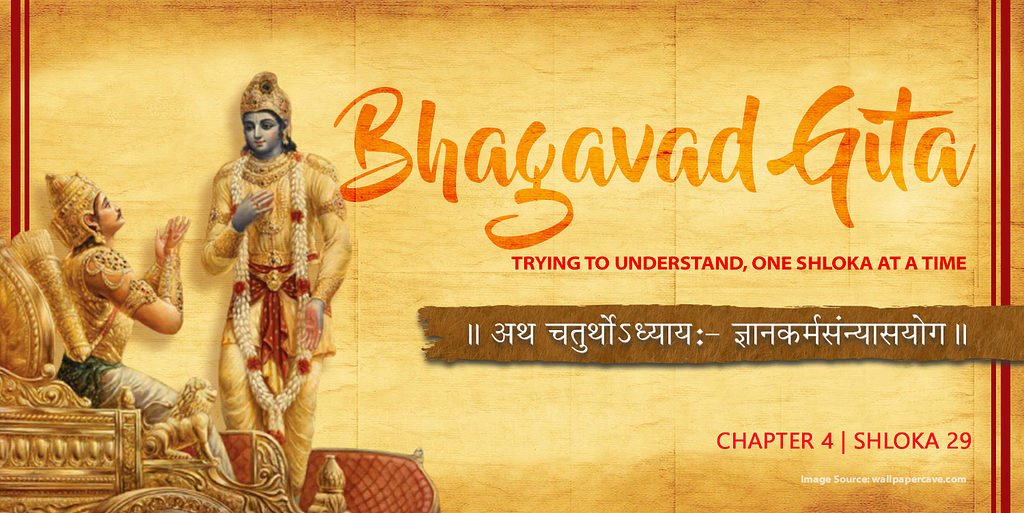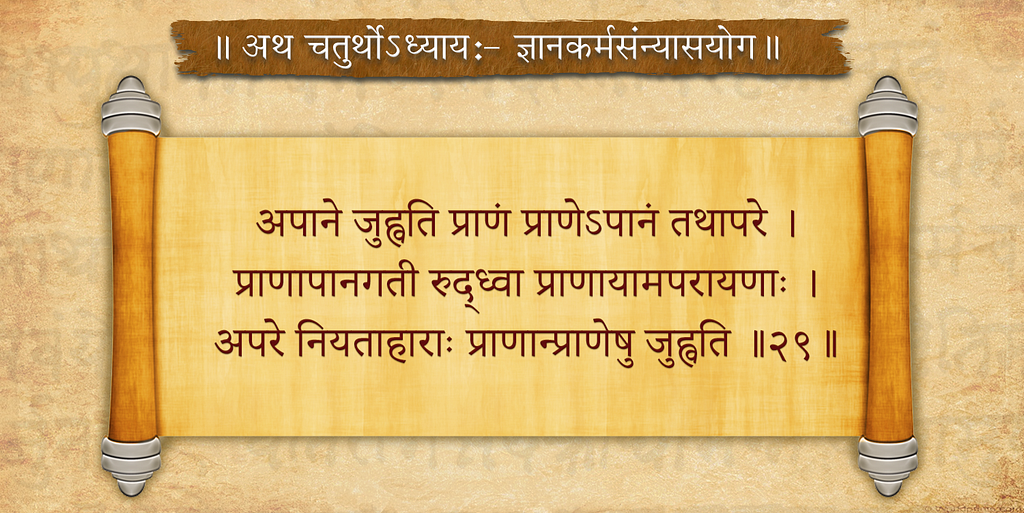H
HBR Patel
Guest
Bhagavad Gita: Understanding One Shloka at a Time. (Chp. 4, Verse 29) — HBR Patel
Trying to understand Bhagavad Gita, one Shloka at a time…

Poster by HBRGraphic
अपाने जुह्वति प्राणं प्राणेऽपानं तथापरे ।
प्राणापानगती रुद्ध्वा प्राणायामपरायणाः ।
अपरे नियताहाराः प्राणान्प्राणेषु जुह्वति ॥२९॥
Some others offer the outgoing breath (prana) into the incoming breath (apana) and the incoming breath to the outgoing breath; in this way checking the flow of both the incoming and outgoing breaths they arduously practice breath control. Others strictly reducing their food intake offer the senses into the life breath.

Poster by HBRGraphic
In this Verse, Bhagwan Shri Krishna explains the unique way of weaving devotional aspects in the simple, automatic, involuntary, and rhythmic act of Breathing. In the fast-paced world, where humans find it hard to savor the proper cooked food and opt for fast foods, who would have thought that centuries ago, Bhagwan Shri Krishna highlighted a simple way of Yagna to Arjun in the battlefield of Kurushektra that would echo until eternity & beyond and guide the humans to offer devotion to Bhagwan is a simple act of breathing consciously.
Bhagwan Shri Krishna discusses the practice of pranayam, emphasizing the technique of offering the exhalation into the inhalation, and vice versa. This reciprocal exchange of breath is regarded as worship or yagna. The method involves Kumbhak, the intentional pause between inhalation and exhalation. Through this practice, individuals consecrate each breath as an offering in the sacred act of yagna.
Let us see what is Pranayam: It is derived from the Sanskrit words “prana,” meaning life force or vital energy, and “ayama,” meaning to extend or draw out. Pranayama involves conscious regulation of the breath, to harmonize the flow of prana in the body.
Four steps:
Puraka: Involves drawing the breath into the lungs.
Rechaka: Encompasses the process of emptying the lungs of breath.
Antar Kumbhak: This entails holding the breath in the lungs after inhalation, where the outgoing breath is suspended within the incoming breath during this period of suspension.
Bahya Kumbhak: Involves keeping the lungs empty after exhalation, with the incoming breath suspended within the outgoing breath during the period of suspension.
Bhagwan Shri Krishna further mentions in the Shloka about the individuals who restrain the intake of food. They practice gradually reducing their food consumption to a minimal level. They utilize this disciplined approach to present their senses, weakened by food scarcity, as an offering in the form of yagna. This practice aligns with Vedic teachings, advocating that the stomach should ideally be half-filled with food, a quarter with water, and the remaining quarter with air.
Specifically, from the Charaka Samhita, an ancient Indian medical text considered one of the foundational works of Ayurveda. This verse appears in the Chikitsa Sthana (chapter on Internal Medicine) of the Charaka Samhita, specifically in the Sutrasthana (aphoristic section), verse 24. The shloka is as follows:
अर्धं भोजनं चतुर्थं जलं चतुर्थं विवर्जयेत् ।
चतुर्थं चानिलेनाप्याप्यायेत् स्वस्थमात्मना ॥ २४ ॥
It means that one should fill half the stomach with food, one-quarter with water, and leave the remaining quarter empty for the movement of air. This is the way to maintain health and well-being
Limiting one’s intake is highly beneficial for managing the senses. Without effective control over the senses, escaping material entanglements becomes an improbable endeavor, especially if one is seeking Moksha.
Continue reading...
